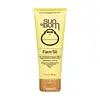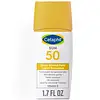What's inside
What's inside
 Key Ingredients
Key Ingredients

 Benefits
Benefits

 Concerns
Concerns

 Ingredients Side-by-side
Ingredients Side-by-side

Butyl Methoxydibenzoylmethane 3%
UV AbsorberHomosalate 10%
Skin ConditioningEthylhexyl Salicylate 5%
UV AbsorberOctocrylene 10%
UV AbsorberWater
Skin ConditioningButyloctyl Salicylate
Skin ConditioningHydrated Silica
AbrasiveVp/Hexadecene Copolymer
Styrene/Acrylates Copolymer
Dimethicone
EmollientPolyester-8
Skin ConditioningTocopheryl Acetate
AntioxidantBHT
AntioxidantGlyceryl Stearate
EmollientPEG-100 Stearate
Ethylhexyl Stearate
EmollientBehenyl Alcohol
EmollientCaprylyl Methicone
Skin ConditioningTrimethylsiloxysilicate
EmollientDimethyl Capramide
Emulsion StabilisingSodium Polyacrylate
AbsorbentXanthan Gum
EmulsifyingTrideceth-6
EmulsifyingDisodium EDTA
Ethylhexylglycerin
Skin ConditioningPolyaminopropyl Biguanide
PreservativeMethylisothiazolinone
PreservativeButyl Methoxydibenzoylmethane 3%, Homosalate 10%, Ethylhexyl Salicylate 5%, Octocrylene 10%, Water, Butyloctyl Salicylate, Hydrated Silica, Vp/Hexadecene Copolymer, Styrene/Acrylates Copolymer, Dimethicone, Polyester-8, Tocopheryl Acetate, BHT, Glyceryl Stearate, PEG-100 Stearate, Ethylhexyl Stearate, Behenyl Alcohol, Caprylyl Methicone, Trimethylsiloxysilicate, Dimethyl Capramide, Sodium Polyacrylate, Xanthan Gum, Trideceth-6, Disodium EDTA, Ethylhexylglycerin, Polyaminopropyl Biguanide, Methylisothiazolinone
Zinc Oxide 12%
Cosmetic ColorantAllantoin
Skin ConditioningBisabolol
MaskingButyloctyl Salicylate
Skin ConditioningC12-15 Alkyl Benzoate
AntimicrobialCaprylyl Glycol
EmollientCaprylyl Methicone
Skin ConditioningDimethicone
EmollientDimethiconol
EmollientEthylhexylglycerin
Skin ConditioningHexylene Glycol
EmulsifyingIsododecane
EmollientLauryl PEG-10 Tris(Trimethylsiloxy)Silylethyl Dimethicone
EmulsifyingLauryl PEG-8 Dimethicone
Niacinamide
SmoothingOctyldodecyl Neopentanoate
EmollientPEG-10
HumectantPhenoxyethanol
PreservativePolymethylsilsesquioxane
Propanediol
SolventSodium Chloride
MaskingSodium Hydroxide
BufferingTetrasodium Glutamate Diacetate
Tocopherol
AntioxidantTrilaureth-4 Phosphate
EmulsifyingWater
Skin ConditioningZinc Oxide 12%, Allantoin, Bisabolol, Butyloctyl Salicylate, C12-15 Alkyl Benzoate, Caprylyl Glycol, Caprylyl Methicone, Dimethicone, Dimethiconol, Ethylhexylglycerin, Hexylene Glycol, Isododecane, Lauryl PEG-10 Tris(Trimethylsiloxy)Silylethyl Dimethicone, Lauryl PEG-8 Dimethicone, Niacinamide, Octyldodecyl Neopentanoate, PEG-10, Phenoxyethanol, Polymethylsilsesquioxane, Propanediol, Sodium Chloride, Sodium Hydroxide, Tetrasodium Glutamate Diacetate, Tocopherol, Trilaureth-4 Phosphate, Water
 Reviews
Reviews

Ingredients Explained
These ingredients are found in both products.
Ingredients higher up in an ingredient list are typically present in a larger amount.
Butyloctyl Salicylate is a chemical UV filter structurally similar to octisalate. It is a photostabilizer, SPF booster, emollient and solvent. This ingredient helps evenly spread out ingredients.
According to a manufacturer, it is suitable for pairing with micro Titanium Dioxide, Zinc Oxide, and pigments.
Photostabilizers help stabilize UV-filters and prevents them from degrading quickly.
Learn more about Butyloctyl SalicylateCaprylyl Methicone is a type of silicone.
It helps soften and soothe the skin by creating a thin film on top. This film helps trap moisture, keeping your skin hydrated.
Dimethicone is a type of synthetic silicone created from natural materials such as quartz.
What it does:
Dimethicone comes in different viscosities:
Depending on the viscosity, dimethicone has different properties.
Ingredients lists don't always show which type is used, so we recommend reaching out to the brand if you have questions about the viscosity.
This ingredient is unlikely to cause irritation because it does not get absorbed into skin. However, people with silicone allergies should be careful about using this ingredient.
Note: Dimethicone may contribute to pilling. This is because it is not oil or water soluble, so pilling may occur when layered with products. When mixed with heavy oils in a formula, the outcome is also quite greasy.
Learn more about DimethiconeEthylhexylglycerin (we can't pronounce this either) is commonly used as a preservative and skin softener. It is derived from glyceryl.
You might see Ethylhexylglycerin often paired with other preservatives such as phenoxyethanol. Ethylhexylglycerin has been found to increase the effectiveness of these other preservatives.
Water. It's the most common cosmetic ingredient of all. You'll usually see it at the top of ingredient lists, meaning that it makes up the largest part of the product.
So why is it so popular? Water most often acts as a solvent - this means that it helps dissolve other ingredients into the formulation.
You'll also recognize water as that liquid we all need to stay alive. If you see this, drink a glass of water. Stay hydrated!
Learn more about Water